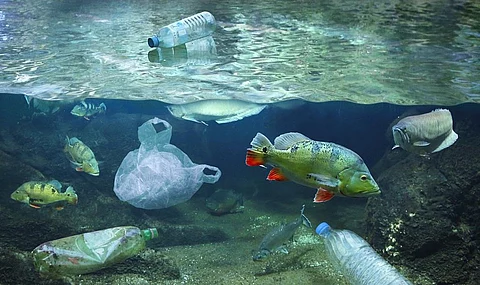

The demand for plastic products has grown drastically in the last few decades. The possible reasons for this dramatic surge can be attributed to its durability, flexibility, lightness and affordability.
Globally, the annual production of plastic reached 460 million tonnes in 2019 and 353 million tonnes of plastic waste were also generated in the same year.
Approximately 50 per cent of plastic waste generated in the same year was dumped in landfills, according to the Organization for Economic Corporation and Development.
In 2021-22, India’s plastic demand was 20.89 million tonnes. About 40 per cent of this gets added to plastic waste after the first use, a Delhi-based non-profit Centre for Science and Environment had found.
A significant portion of single-use plastic gets piled up on coastlines and contributes to the growing burden of marine litter, endangering aquatic biodiversity. In India, anthropogenic activities add approximately eight million tonnes of plastic waste to the marine environment.
Land-based sources such as dumpsites located near the coastlines or banks of a river, flood waters, industrial outfalls, discharge from storm water drains, untreated municipal sewerage, beach litter, tourism, fishing, ship breaking yards, defence-related facilities, automobiles, industrial wastes, natural events, etc are the main factors contributing to the menace of marine litter.
In addition to this, sea-based sources such as waste from ships, fishing vessels and other public transport and research facilities; offshore mining and extraction; legal and illegal waste dumping; ghost nets, natural events, etc add to it.
Tributaries of major Indian rivers also carry around 15-20 per cent of plastic waste into the marine environment. If this trend continues, there may be more plastic than fish in oceans by 2050, warned many recent researchers on this front.
Marine debris can transcend international borders and disperse to faraway locations from its place of origin. Since marine species consume microplastics, they can eventually sweep into our food chain.
Additionally, leached chemicals may also bioaccumulate in these species and endanger human health. Thus, this complicated, multi-layered problem has to be arrested at the earliest to safeguard the health of humans as well as the environment.
Sustainable development goals mandate to “prevent and significantly reduce marine pollution of all kinds, in particular from land-based activities, including marine debris and nutrient pollution by 2025.”
It is estimated that India produces over 65 million tonnes of waste annually, including 62 million tonnes of municipal solid waste.
Of this, around 75-80 per cent of municipal waste is collected and only 25-28 per cent of this collected waste is processed and treated. The discarded municipal solid waste takes the conventional route of natural waterways and becomes part of marine litter.
From July 1, 2022, the Union government banned the manufacturing, selling, use and storage of 19 identified single-use plastic items. Still, the ban is not effective as prohibited items have been found in use in almost every Indian city.
The central and state governments have already allocated a budget to Swachh Bharat Mission (SBM) and disbursed more than Rs 3,000 crore on public awareness campaigns and coastal area cleaning drives.
But the result is not up to mark as consumers still use banned plastic items as waste can still be seen in municipal garbage, beaches and marine debris.
When it comes to Extended Producer Responsibility (EPR), producers, importers and brand owners (PIBO), as well as producer responsibility organisations (PRO), are only focusing only on polyethylene terephthalate, hydrocarbon polymer and low-density polyethylene-based plastic items.
The remaining plastic items are out of their focus and are left to get burnt or become a part of marine debris. That’s why we need effective enforcement of EPR policy with PIBO and PRO-led waste plastic collection centres being set up in the country at a large scale.
Swachh Sagar, Surakshit Sagar, a 75-day citizen-led campaign for improving ocean health through collective action, was launched on July 5, 2022.
It has three strategic underlying goals that target transformation and environmental protection through behaviour change. The three underlying goals of the campaign are: Consume responsibly, segregate waste at home and dispose of it responsibly.
The National Centre for Coastal Research, a body under the Ministry of Earth Sciences, led a coastal cleaning programme covering 7,500 kilometres.
But short-term solutions like coastal cleaning are not enough as abandoned plastic, glasses, thermophones, cigarette butts, fishing gears, multi-layered plastic items, etc can still be seen.
The government needs to enlist multi-layered plastic packaging items in the list of banned items; only 19 plastic items have been considered as of now.
Effective enforcement and penalty against defaulters is required as the government has already spent a lot on public awareness campaigns in the last six year.
There should be strict implementation and monitoring of Coastal Regulation Zone and Special Area Planning guidelines in order to curb haphazard constructions along the coastlines. A National Marine Litter Policy needs to be formulated as early as possible.